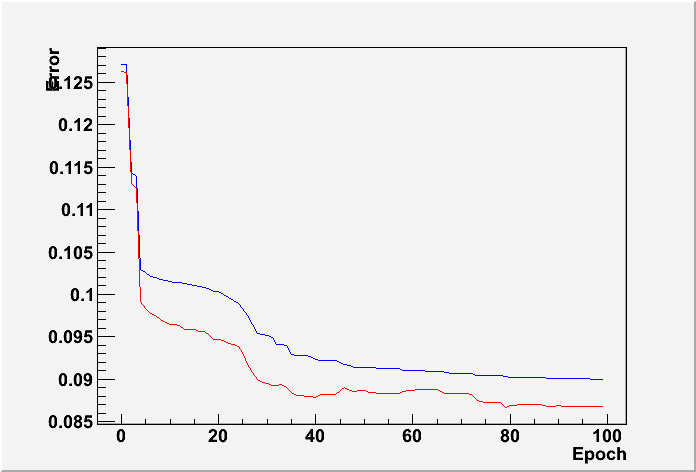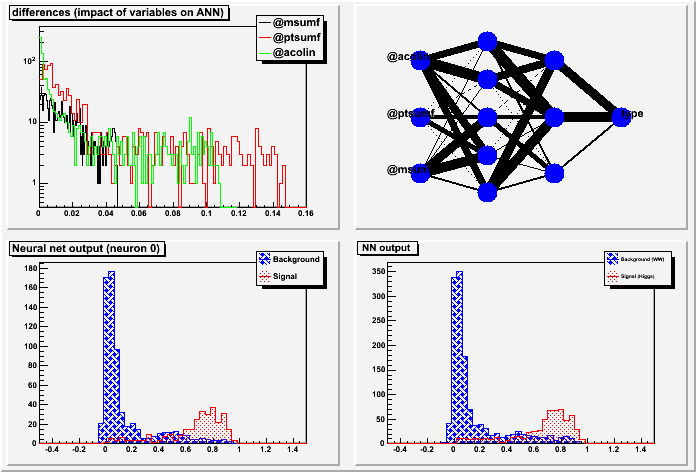void mlpHiggs(Int_t ntrain=100) {
if (!gROOT->GetClass("TMultiLayerPerceptron")) {
gSystem->Load("libMLP");
}
const char *fname = "mlpHiggs.root";
TFile *input = 0;
if (!gSystem->AccessPathName(fname)) {
input = TFile::Open(fname);
} else {
printf("accessing %s file from http://root.cern.ch/files\n",fname);
input = TFile::Open(Form("http://root.cern.ch/files/%s",fname));
}
if (!input) return;
TTree *signal = (TTree *) input->Get("sig_filtered");
TTree *background = (TTree *) input->Get("bg_filtered");
TTree *simu = new TTree("MonteCarlo", "Filtered Monte Carlo Events");
Float_t ptsumf, qelep, nch, msumf, minvis, acopl, acolin;
Int_t type;
signal->SetBranchAddress("ptsumf", &ptsumf);
signal->SetBranchAddress("qelep", &qelep);
signal->SetBranchAddress("nch", &nch);
signal->SetBranchAddress("msumf", &msumf);
signal->SetBranchAddress("minvis", &minvis);
signal->SetBranchAddress("acopl", &acopl);
signal->SetBranchAddress("acolin", &acolin);
background->SetBranchAddress("ptsumf", &ptsumf);
background->SetBranchAddress("qelep", &qelep);
background->SetBranchAddress("nch", &nch);
background->SetBranchAddress("msumf", &msumf);
background->SetBranchAddress("minvis", &minvis);
background->SetBranchAddress("acopl", &acopl);
background->SetBranchAddress("acolin", &acolin);
simu->Branch("ptsumf", &ptsumf, "ptsumf/F");
simu->Branch("qelep", &qelep, "qelep/F");
simu->Branch("nch", &nch, "nch/F");
simu->Branch("msumf", &msumf, "msumf/F");
simu->Branch("minvis", &minvis, "minvis/F");
simu->Branch("acopl", &acopl, "acopl/F");
simu->Branch("acolin", &acolin, "acolin/F");
simu->Branch("type", &type, "type/I");
type = 1;
Int_t i;
for (i = 0; i < signal->GetEntries(); i++) {
signal->GetEntry(i);
simu->Fill();
}
type = 0;
for (i = 0; i < background->GetEntries(); i++) {
background->GetEntry(i);
simu->Fill();
}
TMultiLayerPerceptron *mlp =
new TMultiLayerPerceptron("@msumf,@ptsumf,@acolin:5:3:type",
"ptsumf",simu,"Entry$%2","(Entry$+1)%2");
mlp->Train(ntrain, "text,graph,update=10");
mlp->Export("test","python");
TCanvas* mlpa_canvas = new TCanvas("mlpa_canvas","Network analysis");
mlpa_canvas->Divide(2,2);
TMLPAnalyzer ana(mlp);
ana.GatherInformations();
ana.CheckNetwork();
mlpa_canvas->cd(1);
ana.DrawDInputs();
mlpa_canvas->cd(2);
mlp->Draw();
mlpa_canvas->cd(3);
ana.DrawNetwork(0,"type==1","type==0");
mlpa_canvas->cd(4);
TH1F *bg = new TH1F("bgh", "NN output", 50, -.5, 1.5);
TH1F *sig = new TH1F("sigh", "NN output", 50, -.5, 1.5);
bg->SetDirectory(0);
sig->SetDirectory(0);
Double_t params[4];
for (i = 0; i < background->GetEntries(); i++) {
background->GetEntry(i);
params[0] = msumf;
params[1] = ptsumf;
params[2] = acolin;
params[3] = acopl;
bg->Fill(mlp->Evaluate(0, params));
}
for (i = 0; i < signal->GetEntries(); i++) {
signal->GetEntry(i);
params[0] = msumf;
params[1] = ptsumf;
params[2] = acolin;
params[3] = acopl;
sig->Fill(mlp->Evaluate(0,params));
}
bg->SetLineColor(kBlue);
bg->SetFillStyle(3008); bg->SetFillColor(kBlue);
sig->SetLineColor(kRed);
sig->SetFillStyle(3003); sig->SetFillColor(kRed);
bg->SetStats(0);
sig->SetStats(0);
bg->Draw();
sig->Draw("same");
TLegend *legend = new TLegend(.75, .80, .95, .95);
legend->AddEntry(bg, "Background (WW)");
legend->AddEntry(sig, "Signal (Higgs)");
legend->Draw();
mlpa_canvas->cd(0);
delete input;
}
|
|

